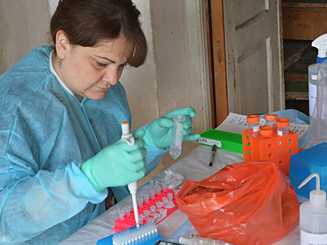Global Disease Detection Program: Georgia and the South Caucasus

Preparing samples following the discovery of a novel orthopox virus in Georgia.
Global Disease Detection (GDD) programs have been operating in the South Caucasus region since 2009. In 2013, this collaboration was broadened through the establishment of a Global Disease Detection Regional Center in Tbilisi, in partnership with DTRA (the Defense Threat Reduction Agency).
The Centers for Disease Control and Prevention (CDC) has been working closely with Georgia’s National Center for Disease Control and Public Health (NCDC), and the Ministries of Health and Ministries of Agriculture in Georgia, Armenia, and Azerbaijan to build public health workforce capacity and strengthen public health systems and institutions needed to effectively respond to health issues in the South Caucasus region. CDC provides ongoing technical assistance in outbreak investigation and development of laboratory and epidemiologic capacity in surveillance for a variety of health risk areas, including enteric diseases, botulism, and dangerous pathogens.
Responding to Health Threats
The scientific priorities for the Regional Center are addressing vaccine preventable diseases, supporting a Hepatitis C control program, combating zoonotic diseases, controlling tuberculosis, and surveillance of hospital acquired infections and enteric diseases.
Building Disease Detection and Response Capacity
Using the International Health Regulations (2005) as an organizing framework, the Center links the strengths of overseas CDC programs with country and regional partners – relying on local rather than remote resources.

A survey team (on the right) investigating a potential outbreak of Crimean-Congo Hemorrhagic Fever, looking for a study participant at the edge of a herding field in Georgia.
The Center’s integrated approach helps reduce detection and response time by developing sustainable regional capacity in:
- Emerging infectious disease detection and response
- Field epidemiology and laboratory training
- Pandemic influenza preparedness and response
- Laboratory systems and biosafety
- Zoonotic disease research and control
- Health communications and information technology
Connecting Resources
In 2014, to strengthen enteric disease surveillance, CDC experts from Division of Foodborne, Waterborne and Environmental Diseases assisted NCDC management and project staff to improve bio-surveillance with a strong emphasis on improving laboratory capacity. In cooperation with Georgia’s Ministry of Health and Ministry of Agriculture, a laboratory training workshop was held.
Additional Resources
Going Above and Beyond to Eliminate Hepatitis C in the Country of Georgia
CDC Global Disease Detection (GDD) Georgia and the South Caucasus
CDC Vital Signs: Hepatitis C
Hepatitis C FAQs for the Public
Wall Street Journal: Gilead to Use a Give-Away Program in Georgia for Reducing Hepatitis C
Georgia Today: Georgian PM Addresses the UN Sustainable Development Summit
Georgia Today: HepC: Hopeful Forecast for “Project of the Century”
Georgia Today: Hepatitis C is Curable, Stigma is the Real Killer
Making a Regional Impact
From 2013-2015, the Center in Georgia has supported:
- Effective response to 13 outbreaks, including 4 outbreaks where support was provided to other countries
- Establishment of laboratory diagnostic testing capacity for 13 pathogens
- Detection of 1 new pathogen, and 1 organism new to the world
- Graduation of 52 future global health leaders from six countries as part of the two-year Field Epidemiology Training Program
- Training of nearly 600 regional public health officials in short term public health exercises, including emergency preparedness, epidemiology, and laboratory diagnostics
- Page last reviewed: April 4, 2016
- Page last updated: April 4, 2016
- Content source:


 ShareCompartir
ShareCompartir